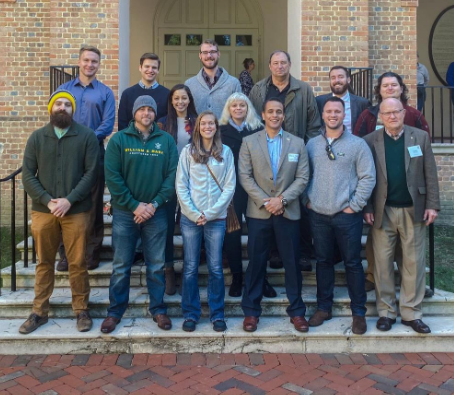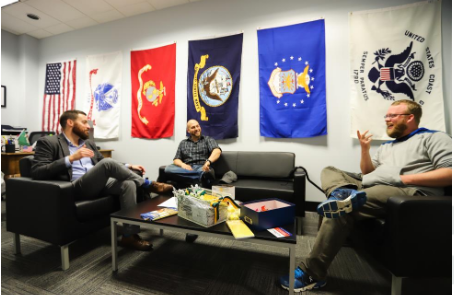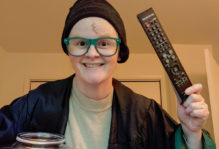Inclusive Excellence – Supporting Student Veterans’ Transition at William & Mary
Guest blogger Charlie Foster shares the past, present, and future of support for student veterans at W&M.
Student veterans lead the way.
In 2014-2015, a group of William & Mary students sought faculty and staff support for creating an on-campus office for student veterans. This effort led to a small grant and the creation of a Center for Veteran Transition, which quickly transformed into a national non-profit that moved to Washington, D.C.: the Armed Services Arts Partnership. Campus leaders also formed a working group of faculty, staff, and students to study the unique circumstances of student veterans on William & Mary’s campus. The working group advised the Student Veterans of America (SVA) chapter and began conducting Green Zone training for faculty and staff, encouraging interested professors and administrators to attend and learn about military culture from student veterans themselves.

Soon after President Rowe began her tenure, she hosted “Thinking Forward,” a series of conversations on the future of W&M’s core mission areas, including service. These sessions reiterated a clear need to better serve student veterans throughout their time at W&M and post-graduation. This focus on service was music to the ears of the Military & Veteran Affairs Working Group. The group reached out to set up a meeting with President Rowe, to share their findings in support of establishing an office to serve student veterans. The case had grown stronger over the years, with William & Mary receiving grants to support the creation of a Troops to Teachers Virginia Center and a Military and Veteran Family Counseling Program, both housed at the School of Education. These achievements added to the considerable success elsewhere on campus, including the Lewis B. Puller Veterans Benefits Clinic at the Law School, the Major General James Wright MBA Program at the Mason School of Business, and the Military Science Department, the only ROTC program in the country that, because of William & Mary’s history of student service, can fly a Revolutionary War battle streamer when they display their unit flag.
A deeper dive into data.
William & Mary boasts deep ties to the nation’s armed forces and a commitment to supporting veterans. In 2018, U.S. News & World Report ranked W&M as the second-best university for veterans in Virginia, and 16th overall. In 2017-18, 251 active duty service members and veterans attended W&M (2.8% of all students). These enrollment figures are impressive relative to the most selective universities in the nation (e.g., 0.6% at Dartmouth; 2.5% at Stanford University) and in our region, including ones with much larger student bodies (e.g., 0.5% at University of Virginia; 0.6% at Virginia Tech). W&M’s commitment to serving veterans reflects our unique history and location: Virginia is the 8th most populous state for veterans, and is expected to climb to 5th place by 2027 (U.S. Department of Veterans Affairs’ Veteran Population Projections for 2017-2037).
Despite our overall success in serving military-affiliated students, the distribution and engagement of these students varies drastically across W&M’s five schools. Our graduate programs excel at serving this cohort. In April 2019, W&M’s Law School was named the nation’s top “military friendly” graduate program, and in 2016 our Raymond A. Mason School of Business placed among the top 15% of military -friendly graduate schools (G.I. Jobs Magazine). These accolades translate into high enrollment: Active duty military represents 8.6% of all graduate students in Business, Law, Education, and Marine Science. In 2017-18, the Business School alone enrolled 60% of all 251 service-members who attended W&M. By contrast, only 40 veterans (0.6% of total enrollment), attended Arts & Sciences’ undergraduate program.
Differences in enrollment reflect disparities in the existing support systems. While our graduate schools offer robust programs that serve area veterans and military-affiliated students (e.g., the Law School’s Puller Veterans Benefits Clinic, the School of Education’s Troops to Teachers Virginia Center, the Business School’s Major General James Wright MBA program), Arts & Sciences provides limited accommodations to these students. Even though pan-university programs exist, such as Green Zone faculty training, they are not being utilized to the same degree by our various constituents.
The proposal.
W&M proposed a pilot, a pan-university Office for Student Veteran Engagement that would centralize and expand existing programs that support recruitment, academic success, wellness, and career guidance of military-affiliated students, with a focus on student veterans. The proposed program had three distinct goals:
- Develop a thorough understanding of the needs and challenges of student veterans.
- Centralize programming for student veterans to facilitate academic, career, and personal success.
- Deepen and broaden relationships with nearby military posts and universities with exemplary student veteran support programs.
W&M requested support from the duPont Fund to hire a Director of Student Veteran Engagement to carry out the pilot program and assess its impact. To inform the Center’s programming, the director visited (physically or virtually) several best-practice programs both regionally and nationally that assist students transitioning from military service into higher education and the civilian workforce. Based on applicable solutions, we have or will adopt successful strategies that align with our student population.
W&M converted a prominent space in the Sadler Center, a popular social and educational facility at the heart of campus, into the Office for Student Veteran Engagement in June 2019. Internal funds outfitted the Center with necessary furniture and technology. Lastly, W&M covered the part-time salary of an administrative assistant to support the director, as well as travel expenses.

Foster, left, talking with students in the new office.
This program will improve the academic and personal experiences of veterans at W&M. Through centralized programming, the Center will engage 100% of military and veteran students (anticipated enrollment for 2019-20 is 250). By coordinating Green Zone training, which educates faculty and staff about the unique needs of student veterans, we will reach faculty and staff across all five schools. Veteran students’ satisfaction with the support structures at W&M will be measured by two surveys administered at the start and end of the pilot year.
We anticipate that these qualitative changes in student engagement will over time result in increased enrollment of military-affiliated students, and a concomitant increase in student diversity on campus. In particular, we seek to boost enrollment of student veterans in Arts & Sciences (currently at 40), with a modest improvement already expected for Fall 2020.
Into the Future.
In short order, we developed a plan and secured a grant from the duPont Foundation to launch the office. With our director in place, the Office of Student Veteran Engagement is poised to make good on our aspirations. As we build our pan-university network, we are centralizing and expanding existing support programs for student veterans that encompass admissions, academic success, wellness, and career guidance. From our student veterans who left William & Mary classrooms to help found the United States, to those who came back from Europe and the Pacific to use the original G.I. Bill, to our student veterans who now attend on the Post-9/11 GI Bill, William & Mary has served service members for centuries. It is an honor to continue this commitment, and make improvements to our programs and services so that we can welcome military and veterans students to our Tribe, as our charter says, “in all time coming.”




No comments.
Comments are currently closed. Comments are closed on all posts older than one year, and for those in our archive.